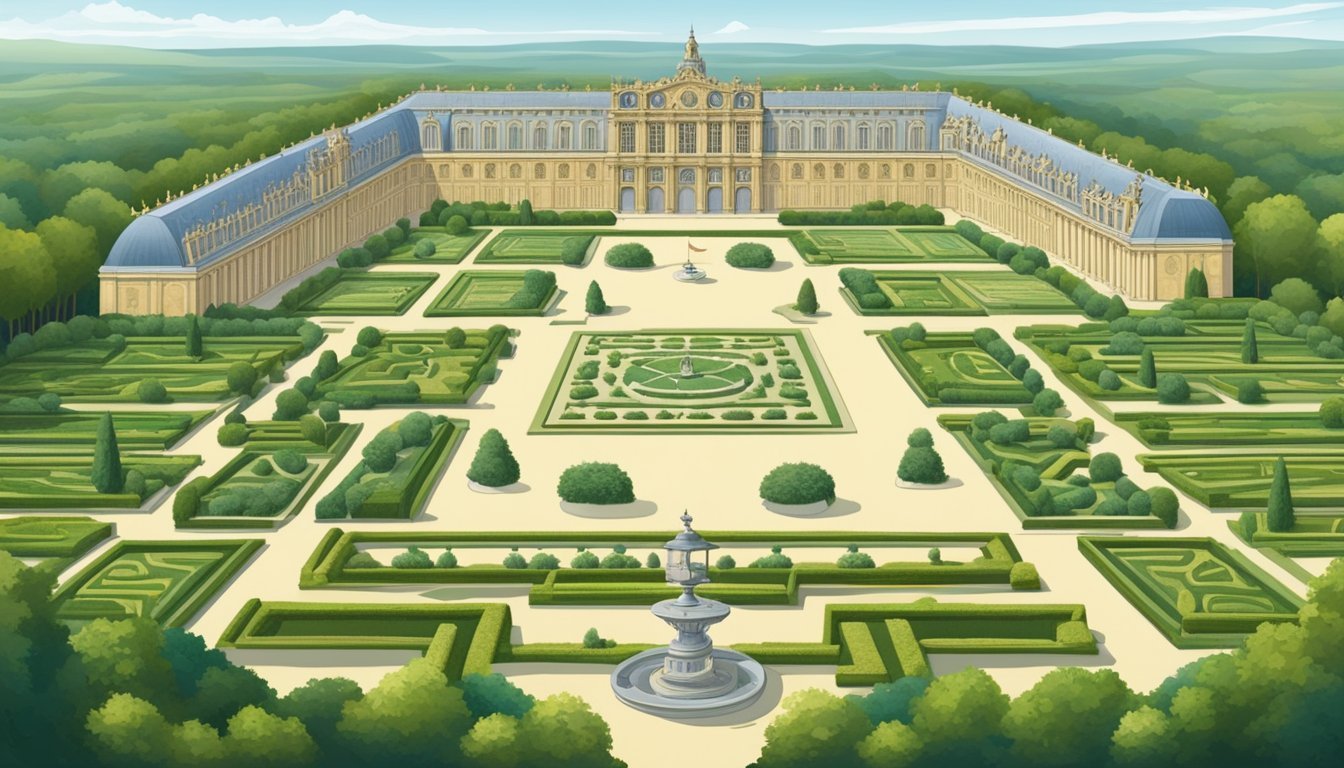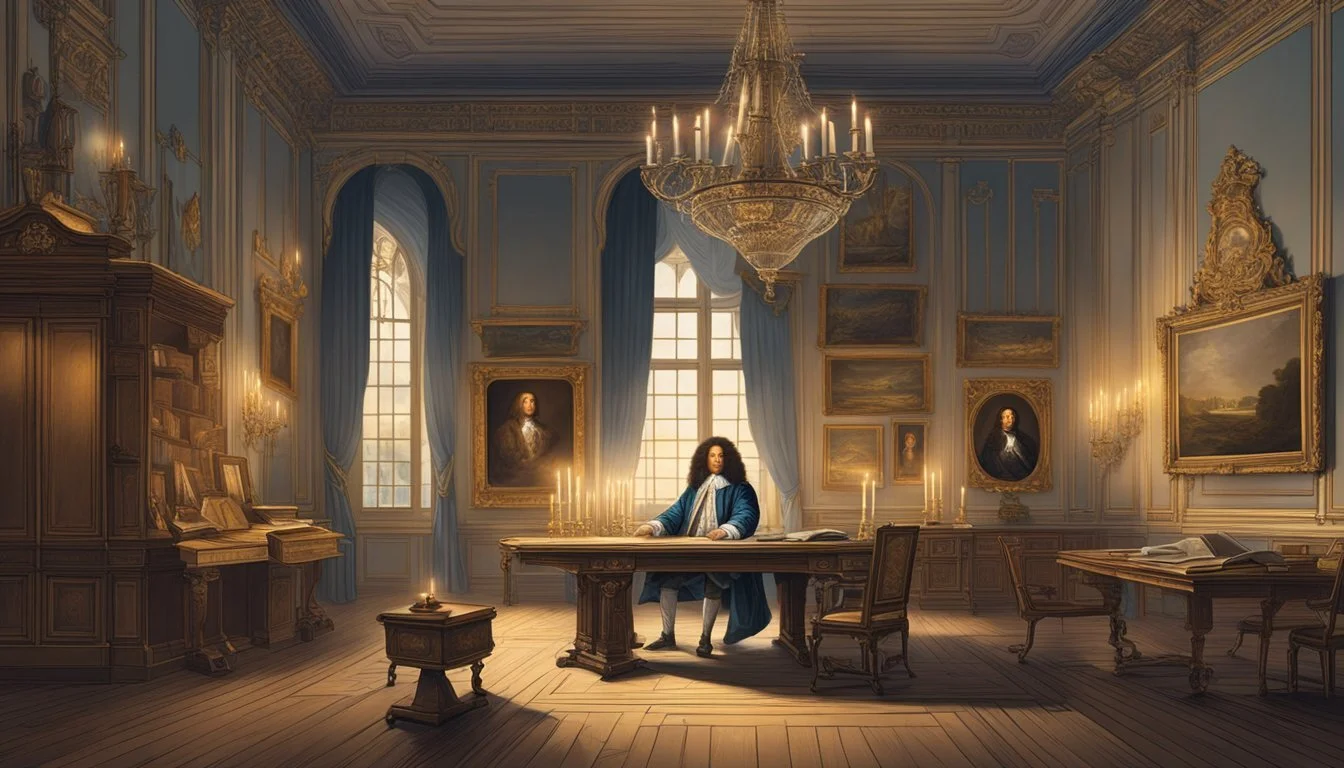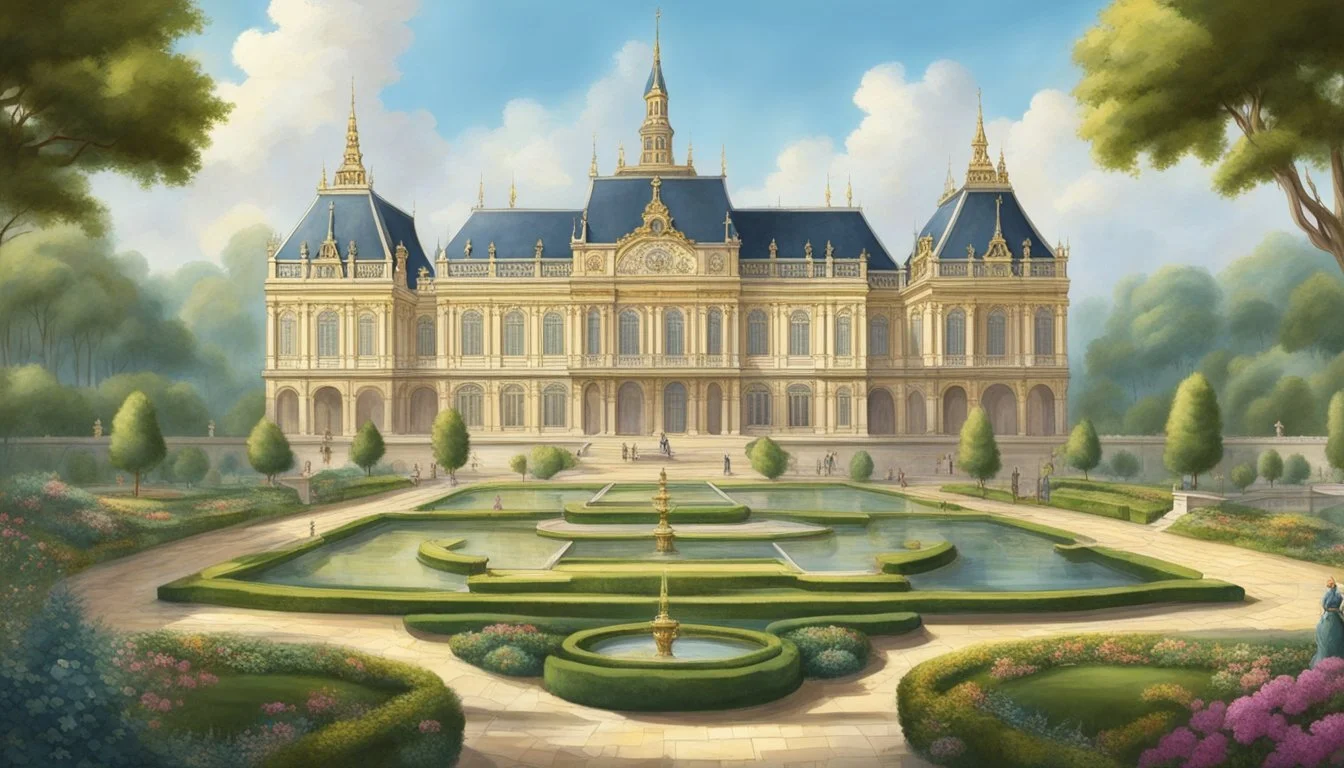6 Films on the Life and Reign of Louis XIV of France
Cinematic Portrayals of the Sun King
Louis XIV of France, known as the Sun King, was one of the most influential monarchs in European history. His long reign from 1643 to 1715 shaped French culture, politics, and society for generations. Several films have brought the life and times of Louis XIV to the silver screen, offering viewers a glimpse into the opulence and intrigue of his court at Versailles.
These cinematic portrayals explore different aspects of Louis XIV's reign, from his rise to power as a young king to his final days on the throne. They depict key events, relationships, and cultural developments that defined his era, showcasing the art, music, and fashion of 17th-century France. Through dramatic recreations and historical interpretations, these films provide audiences with engaging windows into a pivotal period of French history.
1) The Rise of Louis XIV
Roberto Rossellini's 1966 French television film "The Rise of Louis XIV" (La prise de pouvoir par Louis XIV) offers a compelling portrayal of the young monarch's ascension to power. The film focuses on Louis XIV's transition from a figurehead to an absolute ruler following the death of his chief minister, Cardinal Mazarin.
Set in 1661, the movie depicts Louis XIV's strategic maneuvering to consolidate his authority. It showcases his efforts to sideline his mother, Anne of Austria, and outmaneuver ambitious nobles who sought to fill the power vacuum left by Mazarin's passing.
The film highlights Louis XIV's implementation of key policies and practices that would define his reign. These include centralizing power in the monarchy, fostering a culture of opulence at court, and initiating ambitious building projects like the Palace of Versailles.
Rossellini's work stands out for its historically accurate portrayal of 17th-century French court life and politics. The director's attention to period detail and naturalistic acting style lends authenticity to the depiction of Louis XIV's early years as king.
"The Rise of Louis XIV" provides viewers with a nuanced look at the political machinations and personal resolve that enabled the young monarch to establish himself as the Sun King.
2) Vatel
Vatel is a 2000 historical drama film directed by Roland Joffé. It stars Gérard Depardieu as François Vatel, the master of ceremonies and chef to the Prince de Condé in 17th-century France.
The film is set during a three-day feast organized by Vatel for King Louis XIV's visit to the Prince's château. It portrays the opulence and intrigue of the French court during the Sun King's reign.
Uma Thurman plays Anne de Montausier, a love interest for Vatel, while Tim Roth portrays the Marquis de Lauzun. The cast also includes Julian Glover as the Prince de Condé and Julian Sands as King Louis XIV.
Vatel explores themes of duty, love, and the rigid social hierarchy of the time. The film received an Academy Award nomination for Best Art Direction, showcasing the lavish production design of Louis XIV's era.
The story focuses on Vatel's efforts to impress the king with extravagant feasts and entertainment. It depicts the pressure and expectations placed on those serving the nobility during this period of French history.
3) Le Roi Danse
Le Roi Danse, released in 2000, is a Belgian film directed by Gérard Corbiau. The movie explores the relationship between Louis XIV and Jean-Baptiste Lully, the Italian-born composer who became the Sun King's court musician.
The film portrays Louis XIV as a young monarch who uses dance and music to assert his power. It showcases the opulent court life at Versailles and the artistic collaborations that defined the era.
Benoît Magimel stars as the young Louis XIV, capturing the king's passion for dance and his growing authority. Boris Terral delivers a compelling performance as Lully, depicting the composer's ambition and genius.
Le Roi Danse highlights the political significance of art during Louis XIV's reign. It illustrates how the king used cultural spectacles to reinforce his divine right to rule and impress both courtiers and foreign dignitaries.
The movie's lavish costumes and set designs recreate the splendor of 17th-century French court life. Its soundtrack features Lully's compositions, providing an authentic musical backdrop to the unfolding drama.
4) The Taking of Power by Louis XIV
Roberto Rossellini directed this 1966 French television film, also known as "The Rise of Louis XIV." The movie focuses on the young king's ascension to power following the death of Cardinal Mazarin, his chief minister.
Set in the early years of Louis XIV's reign, the film portrays the monarch's strategic moves to assert control over the aristocracy. Rossellini brings his signature realism to the historical drama, offering a fresh take on the costume genre.
Jean-Marie Patte stars as Louis XIV, with Raymond Jourdan and César Silvagni in supporting roles. The film explores the political maneuvering and social dynamics of the French court during this pivotal period.
Rossellini's attention to detail extends to the set design and costumes, recreating the opulence of Versailles. The movie depicts key events such as the construction of the palace and the implementation of Louis XIV's centralized power structure.
At 100 minutes long, "The Taking of Power by Louis XIV" provides an in-depth look at the Sun King's early reign. It stands as a unique blend of historical accuracy and Rossellini's artistic vision.
5) Versailles: Intimate Portraits of France's Sun King
This documentary film offers a close look at Louis XIV's private life within the opulent Palace of Versailles. It explores the daily routines and personal relationships of the Sun King, revealing a more human side to the monarch.
The film showcases the lavish interiors of Versailles, providing context for Louis XIV's grand vision. Viewers are taken through the king's private apartments, offering insights into his tastes and lifestyle.
Interviews with historians and art experts provide commentary on the various portraits and artworks depicting Louis XIV throughout Versailles. These analyses shed light on how the king carefully crafted his image.
The documentary also examines Louis XIV's relationships with his family, courtiers, and mistresses. It delves into the intricate social dynamics of the French court and how the king navigated these complex interactions.
Archival footage and reenactments bring to life key moments in Louis XIV's reign, from elaborate court ceremonies to private meetings with his advisors. This blend of historical detail and visual storytelling creates an engaging portrait of the Sun King.
6) Rembrandt: Caravaggio and the Early Reign of Louis XIV
This film explores the artistic influences during Louis XIV's early reign, focusing on the works of Rembrandt and Caravaggio. It examines how these master painters shaped the young king's artistic tastes and the French court's aesthetic preferences.
The movie highlights Louis XIV's appreciation for Caravaggisti style, as evidenced by his extensive collection of paintings. It showcases nine masterpieces that were once displayed in a central space of the Palace of Versailles, demonstrating the king's refined artistic sensibilities.
The film delves into Louis XIV's understanding of art and architecture, which impressed his contemporaries. It portrays how the young monarch used art as a tool for projecting power and prestige during the early years of his reign.
Viewers gain insight into the cultural atmosphere of 17th-century France and the role of art in shaping Louis XIV's image as the Sun King. The movie illustrates how these artistic influences contributed to the development of French Baroque style.
Through expert commentary and visual recreations, the film brings to life the vibrant artistic scene of Louis XIV's court. It offers a unique perspective on the intersection of art, power, and royal identity in early modern France.
The Historical Context of Louis XIV's Reign
Louis XIV ascended to the French throne during a tumultuous period in European history. His reign spanned over seven decades, transforming France into the dominant power on the continent. The political landscape he inherited and his rise to power shaped the course of his long rule.
Political Landscape of 17th Century France
France in the early 17th century was a fractured nation. Regional nobles held significant power, often challenging royal authority. Religious tensions between Catholics and Protestants simmered following the Wars of Religion. The monarchy faced financial difficulties and internal unrest.
Cardinal Richelieu, chief minister to Louis XIII, had begun centralizing power. He weakened the nobility and strengthened the monarchy's position. This process continued under Cardinal Mazarin during Louis XIV's minority.
European rivalries were intensifying. The Thirty Years' War had reshaped the continental balance of power. Spain's dominance was waning, while France and other nations sought to fill the void.
Louis XIV's Rise to Power
Born in 1638, Louis XIV became king at age 5 upon his father's death. His mother, Anne of Austria, served as regent alongside Cardinal Mazarin. The young king's early years were marked by the Fronde, a series of civil wars that threatened royal power.
The Fronde's failure strengthened Louis's resolve to assert absolute authority. He assumed personal rule in 1661 following Mazarin's death. Louis quickly consolidated power, declaring "L'État, c'est moi" ("I am the state").
He surrounded himself with capable ministers but made it clear he alone would rule. Louis established a strict court etiquette at Versailles, keeping nobles under his watchful eye. His political acumen and longevity on the throne allowed him to reshape France's governance and its role in Europe.
Cultural Innovations Under Louis XIV
Louis XIV's reign ushered in a golden age of French culture, with significant advancements in art, architecture, literature, and music. The Sun King's patronage and vision shaped France's cultural landscape for generations to come.
Art and Architecture in the Sun King's Era
Louis XIV transformed Versailles from a hunting lodge into a grand palace, setting new standards for royal architecture. The Hall of Mirrors, with its 357 mirrors, became an iconic symbol of French opulence and craftsmanship.
The king established the Royal Academy of Painting and Sculpture in 1648, fostering a distinctly French artistic style. Painters like Charles Le Brun and Hyacinthe Rigaud gained prominence, creating works that glorified the monarchy.
Louis XIV's influence extended to urban planning. He commissioned wide boulevards and elegant squares in Paris, including Place Vendôme and Place des Victoires, reshaping the city's landscape.
Impact on French Literature and Music
The French Academy, founded earlier but revitalized under Louis XIV, standardized the French language and promoted literary excellence. Playwrights like Molière and Racine flourished during this period, producing timeless works of theater.
Louis XIV's court became a center for musical innovation. Jean-Baptiste Lully, the king's favorite composer, developed French opera and ballet. The king himself was an accomplished dancer, often performing in court ballets.
The establishment of the Royal Academy of Music in 1669 further solidified France's position as a musical powerhouse. This institution trained musicians and composers, ensuring the continuation of French musical traditions.
Legacy and Influence of Louis XIV
Louis XIV's impact on France and Europe extended far beyond his reign. His architectural and cultural contributions, particularly the Palace of Versailles, continue to captivate millions. Modern cinema has also explored the Sun King's complex life and rule.
The Palace of Versailles
The Palace of Versailles stands as Louis XIV's most enduring legacy. Originally a hunting lodge, he transformed it into a grand royal residence and seat of government.
Today, Versailles attracts over 7 million visitors annually. Its opulent halls, gardens, and fountains showcase the pinnacle of French Baroque architecture and design.
The palace's Hall of Mirrors remains an iconic symbol of Louis XIV's power and artistic patronage. This 73-meter gallery features 357 mirrors, reflecting the king's wealth and grandeur.
Versailles influenced European palace design for centuries. It inspired imitations like Schönbrunn in Vienna and Peterhof in Russia.
Reflections in Modern Cinema
Filmmakers have repeatedly portrayed Louis XIV, exploring different facets of his reign and personality. The 1966 film "The Taking of Power by Louis XIV" focused on his ascension and consolidation of authority.
"Vatel" (2000) depicted the lavish entertainments at Versailles, highlighting the king's demanding nature. The 2014 film "A Little Chaos" took a more fictionalized approach, imagining Louis XIV's involvement in the palace gardens' creation.
These films often emphasize the king's absolute power, complex relationships, and cultural impact. They showcase his elaborate court rituals and the artistic achievements of his reign.
Cinema continues to find new angles on Louis XIV's life, demonstrating his enduring fascination for modern audiences.





